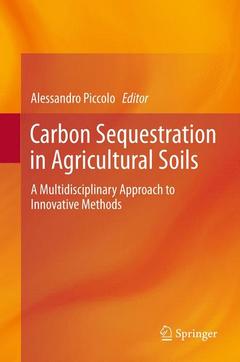Description
Carbon Sequestration in Agricultural Soils, 2012
A Multidisciplinary Approach to Innovative Methods
Coordinator: Piccolo Alessandro
Language: English
Subjects for Carbon Sequestration in Agricultural Soils:
Publication date: 02-2014
310 p. · 15.5x23.5 cm · Paperback
Publication date: 01-2012
310 p. · 15.5x23.5 cm · Hardback
Description
/li>Contents
/li>Comment
/li>
This compilation of techniques, methodologies and scientific data arises from a four-year Italian research project, which took place at university research stations in Turin, Piacenza, Naples and Potenza. Soil Organic Matter (SOM) represents an active and essential pool of the total organic carbon on the planet. Consequently, even small changes in this SOM carbon pool may have a significant impact on the concentration of atmospheric CO2. Recent new understanding of the chemical nature of SOM indicates that innovative and sustainable technologies may be applied to sequester carbon in agricultural soils. Overall results of the project have been applied to develop an innovative model for the prediction and description, both quantitatively and qualitatively, of carbon sequestration in agricultural soils. This book provides experts in different areas of soil science with a complete picture of the effects of new soil management methods and their potentials for practical application in farm management.
- INTRODUCTION
The National FISR-MESCOSAGR project and the multidisciplinary approach to validate the eco-sustainability of new technologies for carbon sequestration in agricultural soils.
-CHAPTER 1
The nature of Soil Organic Matter and global changes
Prof. Alessandro Piccolo (Università di Napoli Federico II), and Dr. Giuseppe Celano, (Università della Basilicata).
-CHAPTER 2
The Kyoto protocol and European and Italian regulations in Agriculture Dr. Donato Sannino and Prof. Alessandro Piccolo (Università di Napoli Federico II).
-CHAPTER 3
The experimental plots, nutrients balance, and productive yields under innovative methods of carbon sequestration.
Prof. Carlo Grignani (Università di Torino) and Prof. Massimo Fagnano (Università di Napoli Federico II).
- CHAPTER 4
The carbon dynamics in the experimental plots. Chemical and physical-chemical aspects.
Dr. Riccardo Spaccini and Prof. Alessandro Piccolo (Università di Napoli Federico II).
- CHAPTER 5
The carbon dynamics in the experimental plots. Use of 13C- and 15N-labelled compounds for the soil-plant balance in carbon sequestration.
Dr. Giuseppe Celano (Università della Basilicata) and Dr. Francesco Alluvione (Università di Torino).
- CHAPTER 6
The carbon dynamics in the experimental plots. Microbiological aspects.
Prof. Giancarlo Moschetti (Università di Palermo) and Prof. Olimpia Pepe (Università di Napoli Federico II).
-CHAPTER 7
The carbon dynamics in the experimental plots. Eco-toxicological aspects.
Prof. Marco Trevisan and Dr. Edoardo Puglisi (Università Cattolica del Sacro Cuore, Piacenza).
-CHAPTER 8
The carbon dynamics in the experimental plots. Biological and biotecnological aspects. Prof. Pacifico Ruggero and Prof Carmine Crecchio (Università di Bari).
-CHAPTER 9
The carbon dynamics in the experimental plots. CO2 and N2O fluxes from agricultural soils.
Prof. Amalia Virzo and Prof. Angelo Fierro (Università di Napoli Federico II).
-CHAPTER 10
Influence of carbon sequestration methods on crop roots architecture.
Prof. Maurizio Badiani et al. (Università Mediterranea, Reggio Calabria).
- CHAPTER 11
New modelling approach to preview and describe carbon sequestration dynamics in agricultural soils.
Prof. Stefano Mazzoleni et al. (Università di Napoli Federico II).
An exploration of an area hardly pursued because of limited understanding of the cycle of organic carbon in soils
A report of the techniques and methodologies used by the research groups during the four-year national Italian project (FISR-MESCOSAGR)
The results have been applied to develop an innovative model to predict and describe, both quantitatively and qualitatively, sequestered organic carbon compounds in the treated soils
Includes supplementary material: sn.pub/extras



